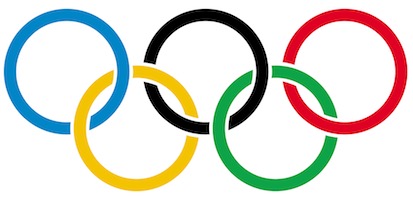
Designed in 1912 by Baron Pierre de Coubertin, the founder of the modern Olympic Games. Public Domain.
Every year countless stories arise of individuals, churches, and small businesses, receiving cease and desist letters from the NFL or NCAA for unauthorized use and reference to their respective SUPER BOWL, MARCH MADNESS, and other trademarks. The success of these enforcement letters comes from a mixture of the organizations’ trademark rights under the Lanham Act and the fear that these financially well-endowed organizations could sue. The International Olympic Committee (“IOC”), and its national governing bodies, like the USOC (collectively the “Olympic Committee”), also aggressively enforce their rights in their Olympic trademarks, slogans, and symbols (the “Olympic properties”). The Olympic Committee not only employs the traditional methods of other sport organizations, but has several additional weapons that provide a true monopoly on the Olympic properties; thus, significantly increase its success.
Ambush marketing underlies the Olympic Committee’s aggressive enforcement. Ambush marketing occurs when non-sponsors attempt to create an unauthorized, false, or misleading and unpaid commercial association with the organization or event, such as the Olympic Movement or Games. Ambush marketing dilutes the value of sponsorship, the life-blood of most sport organizations. In the case of the Olympic Movement, worldwide “TOP” sponsors pay approximately $200 million dollars quadrennially for the exclusive, global rights to use the Olympic properties for a particular category of goods or services. Domestic sponsors pay close to $100 million for similar rights in a specific country. The high costs of Olympic sponsorship in exchange for events that occur for two weeks every two years compels the Olympic Committee to vigilantly monitor and prevent as much ambush marketing as possible, especially in the months leading up to the Games.
In the trademark realm, traditional methods to combat ambush marketing include sending an enforcement letter to usurpers based upon the trademark owner’s prior use, and preferably trademark registrations. Accordingly, the Olympic Committee has trademark registrations across the globe. Generally, this method works, particularly against individuals or small businesses like Olympic Gyro, a Greek food establishment in Philadelphia. The establishment not only used the word OLYMPIC, but also the Olympic rings in connection with the sale of food. In 2012, the USOC sent the establishment a letter requesting the phase out of OLYMPIC and the rings by 2013. The establishment complied and rebranded as OLYMPIA GYRO.
If, however, the situation escalated and litigation ensued, reliance on trademark registrations and the Lanham Act would require the Olympic Committee to prove that a likelihood of confusion existed between the Olympic Committee’s use of its trademarks and the infringer’s use of the same or similar trademarks. Such likelihood of confusion analysis relies on a variety of factors including the similarity of the trademarks, relatedness of the goods, channels of trade, and intent of the infringer. For its more famous marks, the Olympic Committee could also claim trademark dilution, which still requires a multi-factorial analysis. While, many of these factors would weigh in favor of the Olympic Committee, the short time period of the Olympic Games, makes eliminating ambush marketing and infringement time sensitive, and having to prove likelihood of confusion or dilution can cause delay. Therein lies the beauty of Olympic-specific legislation.
The IOC requests that each bidding country enact legislation granting special trademark protection to the Olympic properties to prevent ambush marketing. Since 2000, every host country has adopted such legislation. In the U.S., the Ted Stevens Olympic & Amateur Sports Act established the USOC and gave the USOC exclusive rights to use and license out certain Olympic properties, including but not limited to the Olympic rings, the logos of the Olympic and Paralympics Games, the words “Olympic,” “Olympiad,” and the Olympic motto –“Citius Altius Fortius.” More importantly, the Act allows the USOC to bring civil action against unauthorized users of the Olympic properties or any other trademark, trade name, or symbol tending to cause confusion with the Olympic Committee or Olympic Games. In essence, the USOC can seek injunction to prevent the unauthorized use of the Olympic properties, or other confusingly similar trademark, without proving likelihood of confusion.
While the Act requires the infringing use to be commercial in nature or in association with a theatrical exhibition or athletic event, the Supreme Court in San Francisco Arts & Athletics v. Olympic Committee, upheld the legislation and validated the lack of likelihood of confusion needed to bring civil action by noting that most unauthorized commercial uses of the Olympic properties would tend to cause confusion. This level of trademark monopoly and enforcement power allows the Olympic Committee to quickly gain injunctive relief, when necessary, and generally succeed in snuffing out infringing uses, like Olympic Improv Theater, Olympic Provisions restaurant, the use of the Olympics rings on the Wallenpaupack school district’s crest, and the use of “Ravelympics” for knitting competition held by knitting social network group, Ravelry.
The most controversial method of trademark protection stems from the Olympic Committee’s Rule 40, which creates a black period (July 27th to August 24th for Rio) where, among other things, non-Olympic sponsors cannot use images of Olympic athletes in combination with Olympic properties or references to the Olympic Games. Rule 40 also prohibits companies that sponsor Olympic athletes, but who are not Olympic sponsors themselves, from promoting acknowledging, or even congratulating their athletes on social media. The IOC recently revised Rule 40 to allow companies to obtain a waiver to continue to run advertisements involving Olympic participants; however, the advertisements still cannot contain the Olympic properties or Olympic-related language (Rio, 2016, Medal, Gold, etc…).
Through traditional trademark law, Olympic specific legislation, and its internal marketing rules, the Olympic Committee has monopoly power to protect its Olympic properties and reduce ambush marketing, unrivaled by any other sport league or organization; making it truly the lord of the rings.

![[IPWatchdog Logo]](https://ipwatchdog.com/wp-content/themes/IPWatchdog%20-%202023/assets/images/temp/logo-small@2x.png)

![[Advertisement]](https://ipwatchdog.com/wp-content/uploads/2024/04/Patent-Litigation-Masters-2024-sidebar-early-bird-ends-Apr-21-last-chance-700x500-1.jpg)

![[Advertisement]](https://ipwatchdog.com/wp-content/uploads/2021/12/WEBINAR-336-x-280-px.png)
![[Advertisement]](https://ipwatchdog.com/wp-content/uploads/2021/12/2021-Patent-Practice-on-Demand-recorded-Feb-2021-336-x-280.jpg)
![[Advertisement]](https://ipwatchdog.com/wp-content/uploads/2021/12/Ad-4-The-Invent-Patent-System™.png)







Join the Discussion
No comments yet.